1. Fermentation
1.1. If there's not oxygen for 15 seconds, cells will begin to generate ATP by repeating glycolysis
1.2. Pyruvic acid is reduced by NADH, producing NAD+ which keeps glycolysis going
1.3. by product is lactic acid or alcohol
2. Cellular respiration
2.1. In general
2.1.1. Result: ATP (adenosine triphosphate)
2.1.1.1. Mechanical work
2.1.1.2. Transport work
2.1.1.3. Chemical work (making new compounds)
2.1.2. Occurs on mitochondria
2.1.3. glucose + 6O2 = 6H2O + 6CO2 + Energy
2.2. The metabolic pathway stages
2.2.1. Glycolysis
2.2.1.1. begin the breakdown of glucose and generates some energy
2.2.1.2. in put
2.2.1.2.1. glucose + 2 ATP
2.2.1.3. out put
2.2.1.3.1. 2 pyruvic acid, 2 net ATP, 2 NADH
2.2.1.4. occurs in the cytosol
2.2.2. The citric acid cycle
2.2.2.1. completes the breakdown of glucose
2.2.2.2. first pyruvate is transformed to acetyl CoA
2.2.2.2.1. gives NADH + CO2 each
2.2.2.3. input
2.2.2.3.1. Acetic acid, ADP+P, 3 NAD+, FAD
2.2.2.4. output
2.2.2.4.1. 2 CO2, ATP, 3 NADH, FADH2
2.2.2.5. output for both acetic acids
2.2.2.5.1. 4 CO2, 2 ATP, 6 NADH, 2 FADH2
2.2.2.6. occurs in the mitochondria
2.2.3. Electron transport
2.2.3.1. Generate ATP
2.2.3.2. details
2.2.3.2.1. molecules of ETC are built into the inner membranes of mitochondria
2.2.3.2.2. ETC is a chemical machine that uses energy released by the "fall" of electrons to pump H+ ions across the inner mitochondrial membrane
2.2.3.2.3. those H+ ions store potential energy
2.2.3.2.4. Oxygen pulls the electrons down the chain
2.2.3.2.5. the H+ flow out through ATP synthase and releases energy that is used to make ATP by attaching phosphate group to ADP
2.2.3.2.6. Hydrogen and oxygen then form H2O
2.2.3.2.7. Complexes in the mito membrane
2.2.3.3. input: electrons from (10 NADH, 2 FADH2)
2.2.3.4. output: 28 ATPs and H2O
2.2.3.4.1. 1.5 ATPs for each FADH2
2.2.3.4.2. 2.5 ATPs for each NADH
2.2.3.5. occurs in the mitochondrial membrane
2.2.3.6. 32 ATPs net for each glucose
2.3. Important vitamin precursors
2.3.1. pantothenic acid
2.3.1.1. Coenzyme A
2.3.2. niacin
2.3.2.1. NAD
2.3.3. riboflavin (B2)
2.3.3.1. FAD
2.3.4. cobalamin (B12)
2.3.4.1. amino acid inter-conversion
2.3.5. Biotin
2.3.5.1. conversion of fats used for fuel molecules
2.3.6. Pyroxidine (B6)
2.3.6.1. amino acid inter-conversion and converting glycogen to glucose
2.3.7. Thiamin (B1)
2.3.7.1. coenzyme for removing CO2 molecules
3. Fats
3.1. energy rich, gives twice the ATP from glucose
3.2. Beta oxidation occurs in the mitochondrial matrix
3.3. converts fatty acids to 2-carbon acetyl CoA
3.4. For each acetyl CoA formed
3.4.1. uses 1ATP
3.4.2. gives 1 FADH2 + 1 NADH
